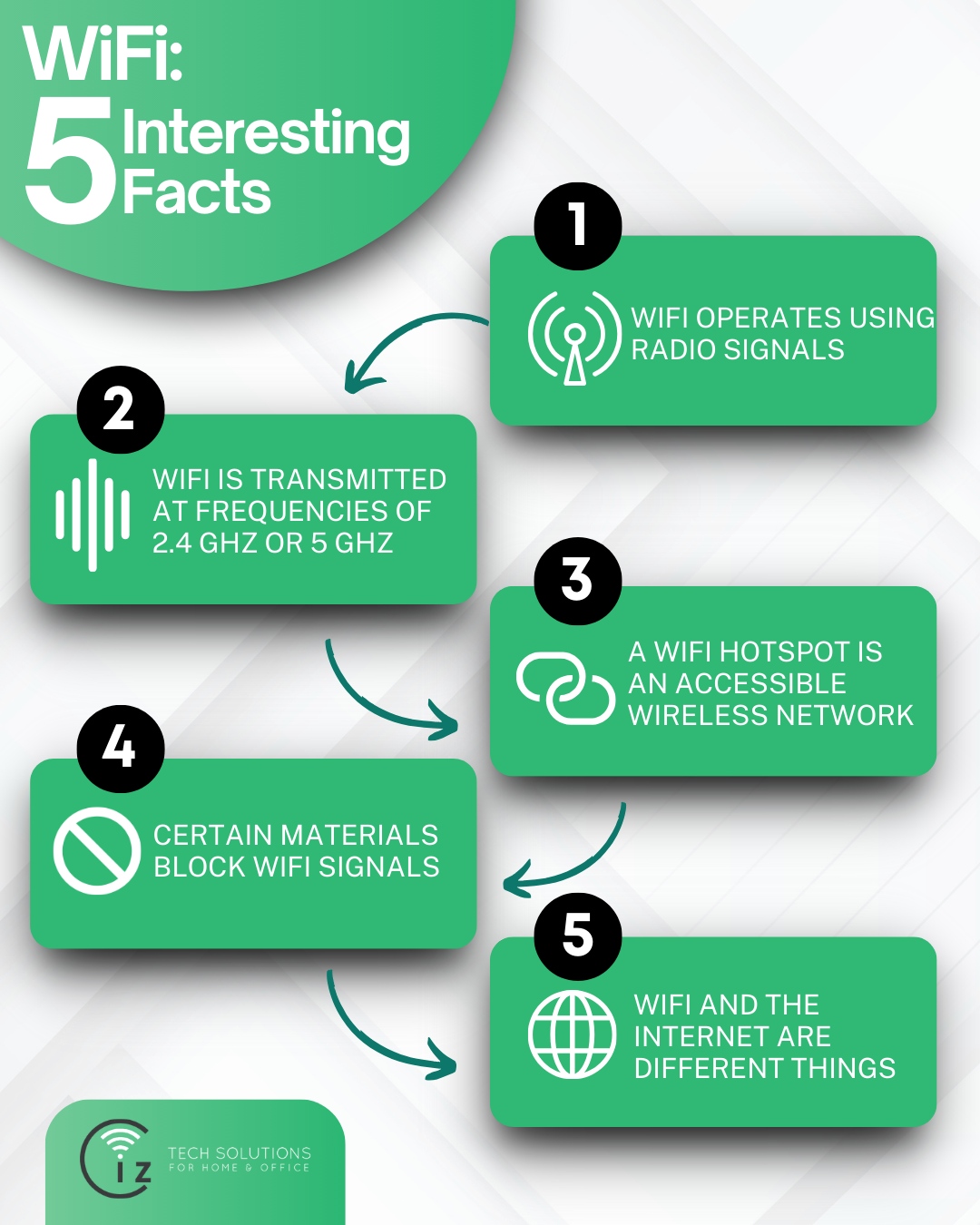WiFi: The Invisible Network That Powers Our World
We live in an age where connectivity is essential. Whether you are streaming your favourite show, working from home, or simply checking your social media, WiFi is the backbone of our digital lives. But how much do we really know about this invisible technology that keeps us connected? Let us dive into some fascinating facts about WiFi that will change the way you think about your internet connection.
☑️ Radio Waves: The Unsung Heroes of Connectivity
WiFi technology relies on a fundamental principle of physics: radio waves. These are electromagnetic waves that travel through the air at the incredible speed of light. To put this into perspective, a radio wave can circumnavigate the Earth almost eight times in a single second!
Imagine radio waves as invisible ripples in the air, carrying information from your WiFi router to your devices and back. This information, whether it is a streaming video, a downloaded file, or a simple web page, is encoded into these waves. The router's antenna transforms electrical signals into radio waves, which are then broadcast into the surrounding environment.
Your WiFi devices, equipped with their own antennas, capture these waves, and convert them back into electrical signals that your device can understand and process. This intricate relationship between transmission and reception happens millions of times per second, creating the seamless wireless connection we rely on.
It is important to note that while radio waves are invisible, they are a form of energy. This energy can be absorbed or reflected by objects in their path, which is why factors like walls, furniture, and even other electronic devices can affect WiFi signal strength. More on that in a bit…
☑️ High Frequency, High Speed: The Battle of the Bands
Your WiFi router operates on specific radio frequencies, measured in gigahertz (GHz). Think of these frequencies as different channels on a radio, each with its own characteristics. The two primary bands used in WiFi are 2.4 GHz and 5 GHz.
The 2.4 GHz Band
The 2.4 GHz band is like a popular radio station with a wide broadcast range. It can penetrate walls and other obstacles more effectively, making it ideal for covering larger areas. However, this popularity comes at a cost. Because many devices, including cordless phones, baby monitors, and even microwave ovens, operate on the same frequency, the 2.4 GHz band can become congested, leading to slower speeds and intermittent connections.
The 5 GHz Band
In contrast, the 5 GHz band is like a less crowded radio station offering faster speeds. It can manage more data traffic simultaneously, resulting in improved performance for activities like online gaming, video streaming, and large file transfers. However, the 5 GHz signal does not travel as far and is more easily blocked by walls and other obstacles.
The Best of Both Worlds
To maximise your WiFi experience, many modern routers offer dual-band capabilities, allowing you to connect devices to either the 2.4 GHz or 5 GHz band based on your needs. For instance, you can use the 2.4 GHz band for devices like smart home gadgets that prioritize range over speed, while connecting your gaming console or streaming devices to the 5 GHz band for optimal performance.
It is important to note that the actual speeds achievable on both bands depend on several factors, including the router's capabilities, the number of connected devices, and the distance between the router and the device.
☑️ WiFi Hotspots: Your Passport to Internet Freedom
WiFi hotspots are public wireless internet access points. They function like mini wireless routers, broadcasting a WiFi signal that multiple devices can connect to simultaneously. This allows users to access the internet without a physical wired connection.
You have likely encountered WiFi hotspots in various places:
- Coffee shops and restaurants: Many establishments offer free WiFi to attract customers and keep them engaged.
- Airports and train stations: These public spaces often provide WiFi to keep travellers connected and entertained during layovers or journeys.
- Hotels and conference centres: These locations typically offer WiFi as a complimentary or paid service for guests.
- Public parks and libraries: Increasingly, cities are installing public WiFi hotspots to provide internet access to residents and visitors.
To connect to a WiFi hotspot, you usually need to select the hotspot's network name from your device's WiFi settings and follow any authentication steps required (like entering a password). Once connected, you can browse the web, send emails, and use other internet services just as you would at home.
Beyond public hotspots, your smartphone can also transform into a personal hotspot. This feature, often called "tethering" or "mobile hotspot," allows you to share your phone's cellular data connection with other devices, creating a portable WiFi network. This is incredibly useful when you need internet access in areas without WiFi coverage.
While Wi-Fi hotspots offer convenient internet access, they also come with security risks. Hackers can intercept your data, steal personal information, or infect your device with malware. To protect yourself, avoid accessing sensitive accounts or conducting financial transactions on public WiFi. Using a Virtual Private Network (VPN) encrypts your data, adding an extra layer of protection. Additionally, keep your device's software and antivirus up to date to guard against threats.
☑️ Overcoming WiFi Obstacles
Achieving a consistent and strong WiFi signal throughout your home or office can often feel like a battle against unseen forces. Walls, floors, and even everyday household appliances can conspire to weaken the signal, creating frustrating dead zones and slow internet speeds.
Understanding the Challenge:
- Physical Barriers: Building materials play a significant role in WiFi signal attenuation. Concrete, brick, and even thick plaster walls can significantly weaken the signal. The denser the material, the more pronounced the impact.
- Metal Obstructions: Metal objects, such as appliances, metal furniture, or even reinforced concrete, can reflect, absorb, or block WiFi signals. This is why placing your router near a metal bookshelf might not be the best idea.
- Wireless Interference: Other wireless devices in your home, like cordless phones, baby monitors, and even microwave ovens, operate on similar frequencies as WiFi. This overlap can cause interference, leading to slower speeds and dropped connections.
Fortifying Your Network:
Now that you understand the culprits behind a weak WiFi signal, let us explore strategies to enhance your network's performance:
- Strategic Router Placement: The location of your router is crucial. Ideally, place it in a central location, away from walls and metal objects. A higher placement can also improve signal dispersion.
- Channel Optimisation: WiFi routers operate on different channels. By selecting a less crowded channel, you can reduce interference from neighbouring networks.
- Antenna Alignment: Experiment with different antenna positions and orientations to maximize signal strength. Some routers offer adjustable antennas, allowing you to fine-tune the signal direction.
- WiFi Extenders: These devices amplify the WiFi signal, extending coverage to areas with weak connections.
- Mesh Networking Systems: For larger homes or complex layouts, mesh systems create a network of interconnected nodes to provide seamless WiFi coverage throughout your space.
By carefully considering these factors and implementing appropriate solutions, you can significantly enhance your WiFi experience, eliminating those frustrating dead zones and enjoying uninterrupted connectivity.
☑️ Internet vs. WiFi
The internet is a vast, interconnected network of computers, servers, and other devices spread across the globe. It is like a massive digital city, bustling with information and communication. To access this global network, you need an internet service provider (ISP). Your ISP acts as your gateway to the internet, providing the necessary infrastructure to connect your home or office to the digital world.
WiFi: Your Local Connection
WiFi, on the other hand, is your local wireless network. It is the technology that allows your devices to connect to the internet without physical cables. Think of WiFi as the bridge between your devices (computers, smartphones, tablets, etc.) and the internet connection provided by your ISP. Your WiFi router acts as the central hub, broadcasting a wireless signal that your devices can pick up.
Conclusion
WiFi is a marvel of modern technology that has become an indispensable part of our lives. By understanding how it works, you can appreciate the complexity behind this simple-to-use tool. From the invisible radio waves to the battle between frequency bands, there is always something new to discover about WiFi. So, the next time you are enjoying a smooth streaming experience or effortlessly browsing the web, take a moment to acknowledge the technology that makes it all possible.

